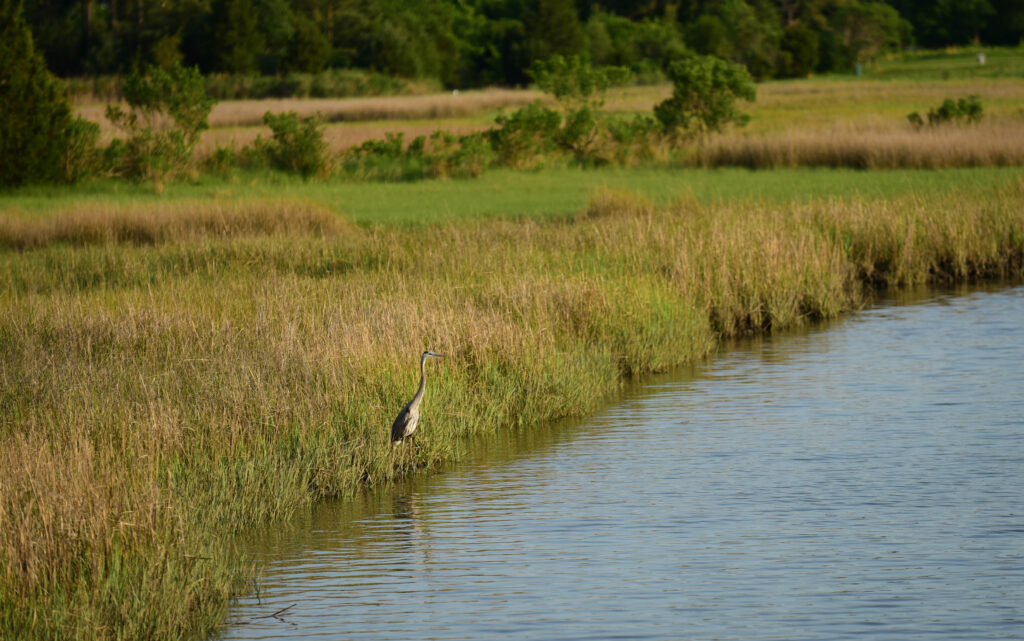A Great Blue Herring stands in brackish water near the Langley Air Force Base nature trail at Joint Base Langley-Eustis, Va., May 10, 2017. Joint Base Langley Eustis is home to species including birds and reptiles like the Great Blue Herring. (U.S. Air Force photo by Staff Sgt. Natasha Stannard)
The Environmental Protection Agency said Friday that the Chesapeake Bay’s “dead zone” is expected to be just 4% larger than normal this summer, despite significantly heavier spring rains that led to a sharp increase in nutrient runoff.
The fact that the dead zone will be only slightly above average after “a season of relatively high stream and river flows indicate that management efforts to keep nutrient runoff out of the Bay watershed is having the desired effect,” said the report from the EPA’s Chesapeake Bay Program.
An official with the Chesapeake Bay Foundation said it could have been worse, but Allison Prost said in a press release that any expansion of the dead zone is worrisome.
“The continued existence of the Chesapeake Bay dead zone is cause for alarm. During the hottest months, far too many areas of the Bay lack enough oxygen to support healthy ecosystems,” said the statement from Prost, the foundation’s vice president for environmental protection and restoration.
But she agreed that the bottom line on the forecast indicates that good work is being done in the Bay watershed.
“The latest dead zone forecast reflects that the longstanding partnership between the federal government and the Chesapeake Bay watershed states has made some strides, particularly from wastewater treatment plant upgrades,” Prost said.
The forecast was released by the EPA’s Chesapeake Bay Program, a regional partnership between jurisdictions in the watershed: New York, Pennsylvania, Delaware, Maryland, Virginia, West Virginia and Washington, D.C.
Dead zones are created when nutrients, such nitrogen and phosphorous, run into the bay and spur algae blooms. When the algae die off the remove oxygen, leaving behind oxygen-deprived dead zones – also known as hypoxic areas – that have the effect of suffocating plant and animal life and diminishing available habitat.
Conditions were ripe this spring for dead-zone creation, according to the EPA report, with “higher-than-average” rainfall and nutrient runoff.
“Stream and river flows to the Chesapeake Bay recorded from January-May 2024 were 63% higher than the previous year and 23% higher than the long-term average,” the report said.
River Input Monitoring stations on the Bay’s nine largest tributaries measured 131 million pounds of nitrogen going into the Bay, 77% higher than the 74 million pounds in 2023. Despite the sharp one-year jump, nitrogen runoff this year is “roughly equal” to the long-term average since 1985, the report said.
But the report estimates that the dead zone, measured in volume, will only be about 4% larger that the long-term average of a 0.97-cubic-mile dead zone since 1985, according the the Bay program. Last year’s dead zone was 0.52 cubic miles, while the largest ever was in 2003, at 1.52 cubic miles.
Researchers will follow up on the Bay dead zone this fall. But Aaron Bever, senior managing scientist at Anchor QEA Inc., which contributes to the report, was hopeful,
“This forecast of an average year for summer hypoxia is further good news, following on the last few years of near or below average amounts of hypoxia in the Chesapeake,” Bever said in a statement released with the report. “Let’s hope weather during the summer helps the Chesapeake realize this forecast.”
Prost explained that more work still needs to be done to meet the 2025 deadline for states to achieve commitments to reduce pollution under the Chesapeake Clean Water Blueprint.
“Now it’s imperative that elected leaders in the Bay watershed states as well as the federal level step up and publicly recommit to the Bay restoration partnership,” her statement said.
The post Chesapeake Bay ‘dead zone’ predicted to be only slightly larger than normal this year appeared first on Maryland Matters.

